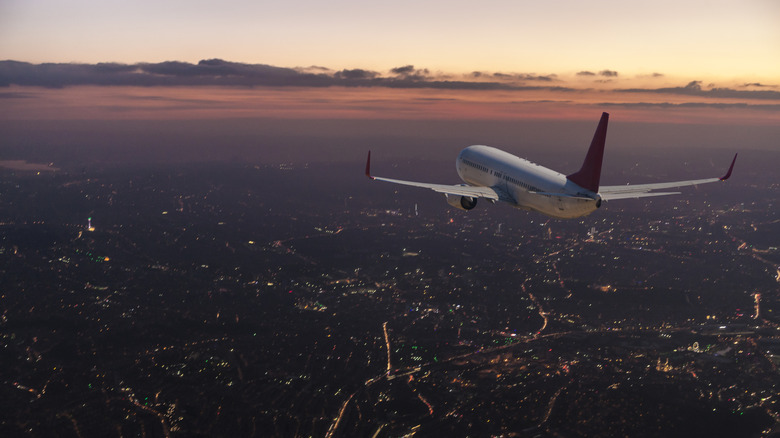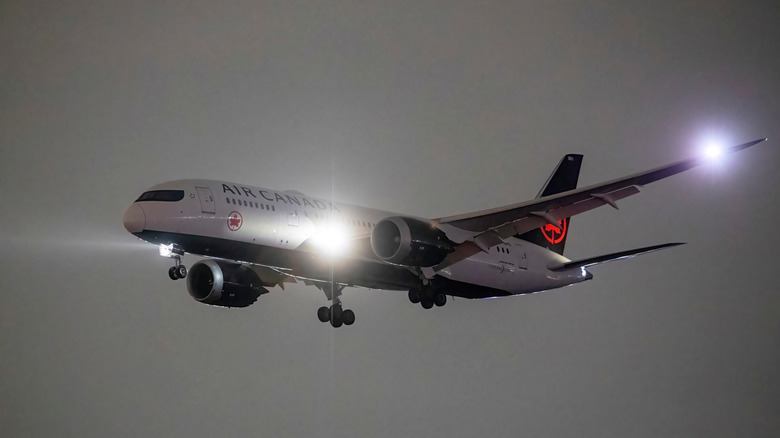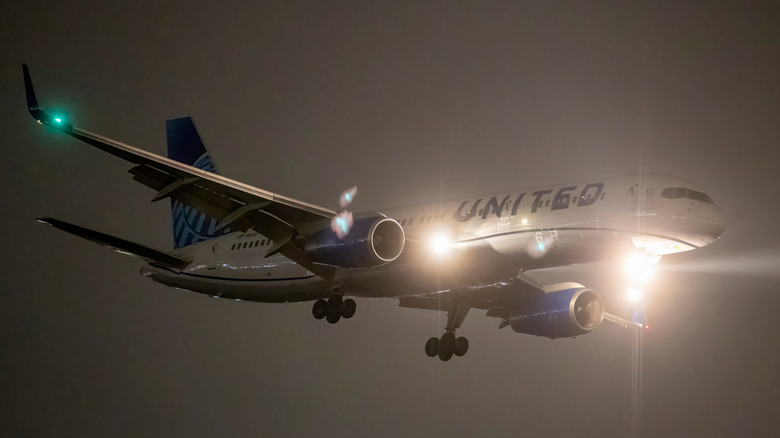Why Do Planes Have Headlights? Here's What They're Used For
It doesn't matter whether you're traveling in the air, water, or road the vast majority of transportation vehicles in each mode have one thing in common: Headlights. You'll find headlights on roadway vehicles like bikes and cars, water transportation vehicles like ships, and air transportation vehicles like airplanes.
But while headlights on bikes and cars help drivers see what's in front of them so they can make informed decisions about their next move, what exactly are airplane headlights used for? Unlike bikes and cars, airplanes follow a pre-configured flight route, and pilots can't change their route mid-air. So why do airplane manufacturers add headlights to their planes?
As it turns out, pilots use a plane's headlights to assist with landing. That's why they're also known as landing lights, and you'll primarily see pilots using them at night. In addition to landing lights, planes are also equipped with other types of lights, such as navigation lights and beacon lights. Each of these lights serves a specific purpose to ensure smooth operation and maximum safety for the aircraft.
Why do airplanes have headlights?
At any good airport, you'll find that the runway is illuminated by dozens of lights placed along its edges. However, small objects or even other aircraft on the runway may not always be visible to the pilot under the light provided by the runway lights. To avoid collisions with such obstacles, pilots use the headlights on their planes to get a clearer view of the runway they are about to land on. Headlights also make the plane more visible to other planes and people. These lights are located on the wings, nose, or fuselage.
Additionally, planes sometimes turn on headlights in areas with reduced visibility, such as coastal or lake regions and places where they are more likely to encounter flocks of birds. Headlights reduce bird strikes by making the plane more visible. When a pilot changes altitude, the aircraft's headlights also help alert nearby planes, making other pilots aware of its position and movement — though this may not be standard practice for all pilots.
Pilots also turn on their headlights during takeoff for the same reason — to better see any obstacles on the runway that they need to be aware of. During landing, pilots are advised to turn on their landing lights when they are flying below 10,000 feet or within 10 miles of an airport. Similarly, during takeoff, pilots keep their landing lights on until they climb above 10,000 feet.
Other types of lights on a plane
In addition to headlights, which are typically white, airplanes use several other types of lights in different colors. The first type is navigation lights, which are used mainly at night and are located on the wingtips and tail of the aircraft. The right wingtip has a green light, the left wingtip has a red light, and the tail has a white navigation light. These lights are installed for observers, mainly air traffic controllers, to help determine the direction in which the plane is flying. For example, if an aircraft is flying directly toward you, you will see the red light on the right and the green light on the left.
Next are beacon lights, which are located on the top and bottom of the plane. These bright red flashing lights are turned on as soon as the plane's engine starts and remain on until the engine is shut off. All modern aircraft, whether commercial planes like the Boeing 777 or advanced fighter jets like the Sukhoi Su-35, use red LED lights as beacons because they are extremely bright and visible from long distances. Finally, there are strobe lights, which are found on both small and large aircraft. These are white flashing lights located on the plane's wings, and pilots turn them on when the aircraft is approaching an active runway. Strobe lights also help improve a pilot's visibility in the dark.


